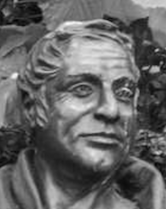
George Joshua Basevi* [commonly known as George Besevi] was born to Jewish parents in Greenwich, Kent [now London], England on 1 April 1794. He trained as an architect under Sir John Soane (1753-1837) in London from 1810 to 1816 during which time he also attended the Royal Academy Schools in London. In 1816 he set out on his Grand Tour of Continental Europe. He returned to England in 1819 and the following year commenced practice as an architect in London. In 1821 he was appointed surveyor to the Guardian Assurance Company.
Basevi was one of the founding fellows of the Society of British Architects [later Royal Society of British Architects] in 1834 and was a Fellow of the Society of Antiquaries (FSA). He died in Ely, Cambridgeshire on 16 October 1845 following a fall while inspecting repairs at the west tower of Ely Cathedral.
* Note some sources, e.g. Wikipedia and Grove Dictionary of Art, give Elias as his first name, however, there is no mention of this being his name in the entry on him in the Dictionary of National Biography or in the authoritative Jewish Encyclopedia which gives Joshua as his middle name
Basevi's first commission was the design of the church of St Thomas, Stockport, Cheshire (1822–25). Other commissions came from his family connections. These included several country houses such as Gatcombe Park, Gloucestershire for David Ricardo (c.1820); and Painswick House, Gloucestershire for W. H. Hyett (1827–32)
From 1825 to 1840 he was employed by W. G. Haldimand to supervise the building of houses in Belgrave Square, London. The success of his work in Belgravia led to a number of other major development projects in London. These included Alexander Square (1827–30) and Thurloe Square (c.1839–45) in South Kensington.
Other architectural works by Basevi included Truesdale's Hospital, Stamford, Lincolnshire (1832); Dr Fryer's almshouses, Stamford, Lincolnshire (1832); Fitzwilliam Museum, Trumpington Street, Cambridge (1837); St Saviour church, Walton Place Chelsea (1839–40); Holy Trinity, Twickenham, Middlesex (1840–41); and Coulsdon rectory, Surrey (1841–43); St Jude church in Chelsea (1843–44); Conservative Club, St. James's Street, London, with Sydney Smirke (1843-45); Parson's almshouses, St Mary Street, Ely, Cambridgeshire (1844–45); and St. Matthew's Church, Ely, Cambridgeshire (1845-46).
_____
For a detailed list of George Basevi's work see also Colvin, Howard. A Biographical Dictionary of British Architects 1600-1840, 4th edition pp. 103-105
_____
See also:
Historic England [link below]
British Listed Buildings [link below]
Avery, Derek. Victorian and Edwardian Architecture. London: Chaucer Press, 2003
Basevi, W. H. F. ‘The grand tour of an architect’. The Architect vol. 108, 1922 pp. 43, 70, 117, 156
Bolton, Arthur Thomas. Architectural Education a Century Ago. Being an Account of the Office of Sir John Soane . . . with Particular reference to the Career of George Basevi. London: Sir John Soane Museum, 1924
Colvin, Howard. A Biographical Dictionary of British Architects 1600-1840 New Haven, Connecticut and London: Yale University Press, 4th edition, 2008 pp.103-105
Cornforth, John. ‘The Fitzwilliam Museum, Cambridge’. Country Life vol. 132, 22 November 1962 pp. 1278-1281 [Part one of a two part article on George Basevi’s 1835 competition-winning designdesigns for the Fitzwilliam Museum]
Cornforth, John. ‘The Fitzwilliam Museum, Cambridge’. Country Life vol. 132, 29 November 1962 pp. 1340-1343 [Part two of a two part article on George Basevi’s 1835 competition-winning designdesigns for the Fitzwilliam Museum]
Directory of British Architects 1834-1914. Compiled by Antonia Brodie, et al. Volume 1: A-K. London; New York: British Architectural Library, Royal Institute of British Architects/Continuum, 2001
Hobhouse, Hermione. ‘The building of Belgravia’. Country Life vol. 145, 8 May 1969 pp. 1154-1157 [Part one of a two part article in which Balsevi’s designs for the Belgravia aria of London are discussed]
Hobhouse, Hermione. ‘The building of Belgravia’. Country Life vol. 145, 22 May 1969 pp. 1312-1314 [Part two of a two part article in which Balsevi’s designs for the Belgravia aria of London are discussed]
Jamilly, Edward. ‘Anglo-Jewish architects and architecture in the 18th and 19th centuries’. Transactions (Jewish Historical Society of England) vol. 18, 1953-55 pp. 127-141
Jordan, Marc L. A. The Life and Work of George Basevi (1794-1845). MA thesis, University of London, Courtauld Institute of Art, 1979
Kadish, Sharman. ‘Constructing Identity: Anglo-Jewry and Synagogue Architecture’. Architectural History vol. 45, 2002 pp. 386-408
Laidlaw, Petra. 'Islington's early Jewish architects'. Journal of the Islington Archaeology & History Society, vol 8, no 3, Autumn 2018 pp. 10-11 [Available online: http://www.clcomms.com/iahs/2018/iahs-autumn-2018.pdf]
‘Memoir of George Basevi, Esq.’. The Builder vol. 3. 1845 pp. 510–11
Ramsey, Stanley C. ‘London clubs’. Architectural Review vol. 35, March 1914 pp. 652-653 [Discusses the Conservative Club in London designed by George Balsevi and completed in 1845]